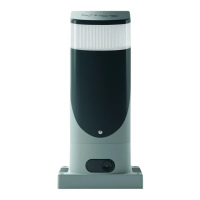ENGLISH – 13
5.5 CHECKING THE GATE MOVEMENT
Once the leaf length has been learned, it is advisable to car-
ry out a few manoeuvres in order to verify that the gate moves
properly.
1.6AT
L1L2L3L4L5L6L7L8
OpenStop/SetClose
26
To do this:
1. press the [Open
p
] button to open the gate; check that
the gate opens regularly without any variations in speed;
the leaf must only slow down when it is between 70 cm
and 50 cm from the opening limit switch and then stop at
2–3 cm from the opening mechanical stop when the limit
switch triggers
2. press the [Close
q
] button to close the gate; check that
the gate closes regularly without any variations in speed;
the leaf must only slow down when it is between 70 cm
and 50 cm from the closing limit switch and then stop at
2–3 cm from the closing mechanical stop when the limit
switch triggers
3. during the manoeuvre, check that the warning light ash-
es with 0.5 s on/0.5 s off intervals. If present, also check
that the indicator connected to the OGI terminal ashes:
slow during the opening movement, fast during the clos-
ing movement
4. open and close the gate several times to make sure that
there are no points of excessive friction and that there are
no defects in the assembly or adjustments
5. check that the gearmotor, rack and limit switch brackets
are solid, stable and suitably resistant even during sud-
den gate acceleration or slowdown movements.
5.6 CONNECTING OTHER DEVICES
If the user needs to power external devices, such as a proxim-
ity reader for transponder cards or the light of the key selector
switch, power can be tapped as shown in the gure.
The power supply voltage is 24Vc -30% ÷ +50% with a maxi-
mum available current of 100mA.
STOP
SBS
(-) (+)
27
TESTING AND COMMISSIONING
6
6 TESTING AND COMMISSIONING
These are the most important phases of the automation’s con-
struction, as they ensure maximum safety of the system. The
test can also be used to periodically verify the devices making
up the automation.
m
Testing and commissioning of the automation must
be performed by skilled and qualied personnel,
who are responsible for the tests required to ver-
ify the solutions adopted according to the risks
present, and for ensuring that all legal provisions,
standards and regulations are met, in particular all
the requirements of the EN 12445 standard, which
denes the test methods for checking gate automa-
tions.
The additional devices must undergo specic testing, both in
terms of their functions and their proper interaction with the con-
trol unit. Refer to the instruction manuals of the individual devic-
es.
6.1 TESTING
To run the test:
1. verify that all the instructions stated in the “GENERAL
SAFETY WARNINGS AND PRECAUTIONS” chapter
have been strictly observed
2. unlock the gearmotor as indicated in the “Manually un-
locking and locking the gearmotor” paragraph
3. make sure that the leaf can be moved manually during
both the opening and closing phases with a force not ex-
ceeding 390N (roughly 40 kg)
4. lock the gearmotor
5. using the control devices (transmitter, control button, key
selector, etc.), test the gate’s opening, closing and stop-
page movements to make sure that the leaves move as
intended. Several tests should be carried out to assess
the movement of the leaves and detect any defects in the
installation and adjustment, besides any points of exces-
sive friction
6. check, one-by-one, that all safety devices mounted on the
system (photocells, sensitive edges, etc.) work properly.
Each time a device intervenes, the “Bluebus” LED on the
control unit will emit two faster ashes to conrm the rec-
ognition
7. if potentially dangerous situations due to the movement
of the leaves have been prevented by limiting the impact
force, the latter must be measured according to the EN
12445 standard and, if the “motor force” control is used
to aid the system in reducing the impact force, it is neces-
sary to test various adjustments to nd the one that gives
the best results.
6.2 COMMISSIONING
a
Commissioning can only be performed after all test-
ing phases have been successfully completed.
a
Before commissioning the automation, ensure that
the owner is properly informed of all residual risks
and hazards.
a
The gate cannot be commissioned partially or un-
der “temporary” conditions.

